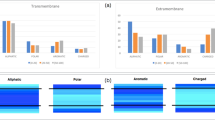Abstract
Structural and environmental constraints greatly simplify the folding problem for membrane proteins. Computational methods can be used in a global search to find a small number of chemically reasonable models within these constraints, such that a modest set of experimental data can distinguish among them. We show that for phospholamban, the global search can be further simplified by reducing the problem to two-body, rather than many-body, interactions. This method of a constrained global search combined with experimental mutagenesis data yields a three-dimensional structure for this pentameric ion channel. The model is a left-handed symmetric homopentamer of α-helices with a well-defined channel, lined solely by hydrophobic residues.
This is a preview of subscription content, access via your institution
Access options
Subscribe to this journal
Receive 12 print issues and online access
$189.00 per year
only $15.75 per issue
Buy this article
- Purchase on Springer Link
- Instant access to full article PDF
Prices may be subject to local taxes which are calculated during checkout
Similar content being viewed by others
References
Kirchberger, M.A., Tada, M. & Katz, A.M. Phospholamban: a regulatory protein of the cardiac sarcoplasmic reticulum. Recent Advances in Studies on Cardiac Structure and Metabolism 5, 103–115 (1975).
James, P., Inui, M., Tada, M., Chiesi, M. & Carafoli, E. Nature and site of phospholamban regulation of the Ca2+ pump of sarcoplasmic reticulum. Nature 342, 90–92 (1989).
Simmerman, H.K.B., Lovelace, D.E. & Jones, L.R. Secondary structure of detergent solubilized phospholamban, a phophorylatable, oligomeric protein of cardiac sarcoplasmic reticulum. Biochim. biophys. Acta 997, 322–329 (1989).
Kovacs, R.J., Nelson, M.T., Simmerman, H.K.B. & Jones, L.R. Phospholamban forms Ca2+-selective channels in lipid bilayers. J. biol. Chem. 263, 18364–18368 (1988).
Arkin, I.T., Moczydlowski, E.G., Aimoto, S., Smith, S.O. & Engelman, D.M. Functional and structural studies of phospholamban as a model ion channel protein. Biophys. J. 64, A207 (1993).
Wallace, B.A. & Ravikumar, K. The gramicidin pore: crystal structure of the caesium complex. Science 241, 182–187 (1988).
Fox, R.O. & Richards, F.M. A voltage-gated ion channel model inferred from the crystal structure of alamethicin at 1.5 Å resolution. Nature 300, 325–330 (1982).
Cascio, M. & Wallace, B.A. Conformation of alamethicin in phospholipid vesicles, implications for insertion models. Proteins 4, 89–98 (1988).
Unwin, N. Nicotinic acetylcholine receptor at 9 Å resolution. J. molec. Biol. 229, 1101–1124 (1993).
Treutlein, H.R., Lemmon, M.A., Engelman, D.M. & Brünger, A.T. The glycophorin A transmembrane domain dimer: Sequence-specific propensity for a right-handed supercoil of helices. Biochemistry 31, 12726–12733 (1992).
Lemmon, M.A., Treutlein, H.R., Adams, P.D., Brünger, A.T. & Engelman, D.M. A dimerization motif for transmembrane α-helices. Nature struct. Biol. 1, 157–163 (1994).
Arkin, I.T., Adams, P.D., MacKenzie, K.R., Lemmon, M.A., Brünger, A.T. & Engelman, D.M. Structural organization of the pentameric transmembrane α-helices of phospholamban, a cardiac ion channel. EMBO J. 13, 4757–4764 (1994).
Lemmon, M.A. & Engelman, D.M. Specificity and promiscuity in membrane helix interactions. Q. Rev. Biophys. 27, 157–218 (1994).
Lemmon, M.A., Flanagan, J.M., Treutlein, H.R., Zhang, J. & Engelman, D.M. Sequence-specific dimerization of transmembrane α-helices. Biochemistry 31, 12719–12725 (1992).
Popot, J.L. & Engelman, D.M. Membrane protein folding and oligomerization: the two-stage model. Biochemistry 29, 4031–4037 (1990).
Novotny, J., Rashin, A.A. & Bruccoleri, R.E. Criteria that discriminate between native proteins and incorrectly folded models. Proteins 4, 19–30 (1988).
Nilges, M. & Brünger, A.T. Automated modeling of coiled coils: Application to the GCN4 dimerization region. Prot. Engng. 4, 649 (1991).
DeLano, W. & Brünger, A.T. Helix packing in proteins: prediction and energetic analysis of dimeric, trimeric, and tetrameric GCN4 coiled coil structures. Proteins 20, 105–124 (1994).
Kerr, I.D., Sankararamakrishnan, R., Smart, O.S. & Sansom, M.S.P. Parallel helix bundles and ion channels: Molecular modeling via simulated annealing and restrained molecular dynamics. Biophys. J. 67, 1501–1515 (1994).
Menestrina, G., Voges, K.-P., Jung, G. & Boheim, G. Voltage-dependent channel formation by rods of helical polypeptides. J. membrane Biol 93, 111–132 (1986).
Lear, J.D., Wasserman, Z.R. & DeGrado, W.F. Synthetic amphiphilic peptide models for protein ion channels. Science 240, 1177–1181 (1988).
Bertrand, D., Galzi, J.L., Devillers-Thiéry, A., Bertrand, S. & Changeux, J.P. Stratification of the channel domain in neurotransmitter receptors. Curr. Opin. Cell Biol. 5, 688–693 (1993).
Xu, M. & Akabas, M.H. Amino acids lining the channel of the g-aminobutyric acid type A receptor identified by cysteine substitution. J. biol. Chem. 268, 21505–21508 (1993).
Brünger, A.T. X-PLOR Version 3.1 (Yale University, New Haven, CT, 1992).
Brooks, B.R., Bruccoleri, R.E., Olafson, B.D., States, D.J., Swaminathan, S. & Karplus, M. CHARMM: A program for macromolecular energy, minimization, and dynamics calculations. J. comp. Chem. 4, 187 (1983).
Ryckaert, J.P., Ciccotti, G. & Berendsen, H.J.C. Numerical integration of the Cartesian equations of motion of a system with constraints: Molecular dynamics of n-alkanes. J. comp. Phys. 23, 327–341 (1977).
Berendsen, H.J.C., Postma, J.P.M., Van Gunsteren, W.F., DiNola, A. & Haak, J.R. Molecular dynamics with coupling to an external bath. J. Chem. Phys 81, 3684–3690 (1984).
Nicholls, A. & Honig, B. GRASP Manual. (Columbia University, New York, NY, 1992).
Author information
Authors and Affiliations
Rights and permissions
About this article
Cite this article
Adams, P., Arkin, I., Engelman, D. et al. Computational searching and mutagenesis suggest a structure for the pentameric transmembrane domain of phospholamban. Nat Struct Mol Biol 2, 154–162 (1995). https://doi.org/10.1038/nsb0295-154
Received:
Accepted:
Issue Date:
DOI: https://doi.org/10.1038/nsb0295-154
This article is cited by
-
Structural basis for assembly of vertical single β-barrel viruses
Nature Communications (2019)
-
General rules for the arrangements and gating motions of pore-lining helices in homomeric ion channels
Nature Communications (2014)
-
Phospholamban phosphorylation increases the passive calcium leak from cardiac sarcoplasmic reticulum
Pflügers Archiv - European Journal of Physiology (2012)
-
A new approach to the prediction of transmembrane structures
Science Bulletin (2008)
-
Studies of Receptor Tyrosine Kinase Transmembrane Domain Interactions: The EmEx-FRET Method
Journal of Membrane Biology (2007)



